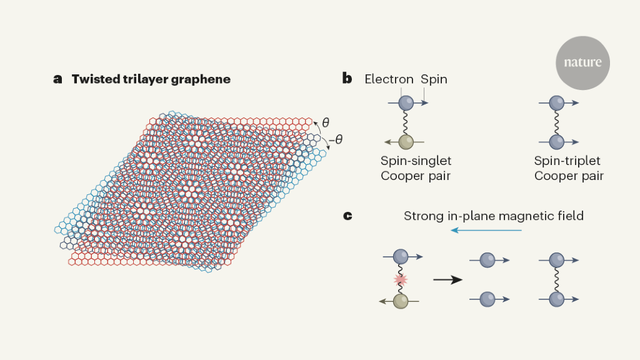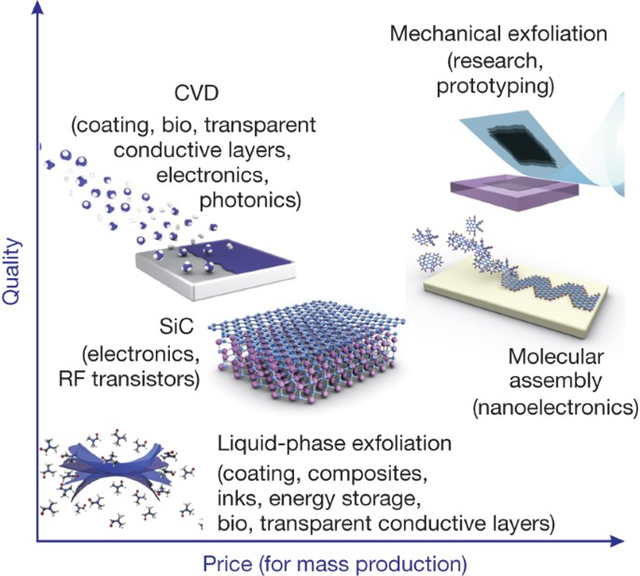How could Graphene change the world?
Hasad Foods, the agricultural investment arm of Qatar's sovereign wealth fund, said the government would increase its grain reserves from 250,000 tons to 300,000 tons in the near future, which is enough to feed the population for six months.
With a lot of deserts, Qatar suffers from water shortages, and Qatar depends on food imports for a long time. Recently, the ongoing tension in Ukraine has caused global food supply tension and rising prices.
In addition to that, the geopolitical situation also affects the supply and prices of many commodities like the graphene powder.
Graphene, like diamonds and graphite, is made of carbon, but its atoms are arranged in a different way.
Diamonds and graphite are both made of carbon atoms, but because the carbon atoms are arranged differently, one is strong and the other is very fragile. Diamonds are particularly hard because each carbon atom is linked to four other carbon atoms around it, forming a tetrahedral structure. In graphite, each carbon atom is linked to three other carbon atoms, which form regular hexagonal rings in the same plane and stretch out to form lamellar structures.
Graphene, on the other hand, is like layers of mesh stacked on top of each other. Each layer is like a honeycomb, and the mesh is hexagonal, so both graphite and graphene are soft.
Essentially, graphene is a particularly thin form of graphite. The thinnest carbon atoms are only one layer thick, which is almost negligible, so graphene is also considered a "two-dimensional structure."
Graphene key properties
thin and light
Graphene is the thinnest and lightest material known and is almost completely transparent to light.
strong
It is said to be 200 times stronger than steel.
thermal conductive
They conduct electricity and heat particularly well, and absorb light well, which could be used to make superconductors.
energy conservative and environmentally-friendly
Many companies are trying to decarbonize waste to make graphene. Not only does this make it easier to reuse the material and reduce carbon emissions, but composites made with graphene are lightweight and strong.
Graphene applications
Graphene cell
Graphene can be used as a graphene battery because of its special electrical and thermal properties. Graphene is already widely used in the manufacture of batteries, which can be used to improve the performance of batteries. Graphene could make batteries in electric cars lighter, last longer, and charge faster. If the technology is mature, it can be charged in five minutes and run 10 kilometers.
In 2020, foreign media reported that the Karlsruhe Institute of Technology in Germany has produced a series of graphene super batteries that can be fully charged in 15 seconds. It is a hybrid battery pack that combines lithium-ion and ultracapacitor batteries to their advantage when working together.
Lithium batteries have a high energy density, which means they can store a lot of energy, but their power density is low, which means they charge and discharge more slowly. So, with the supercapacitor, it can be a very good fast charge and fast discharge. It is said that it can be recharged 100,000 times without degradation.
Superconducting materials
One team created a superconducting material (a material that allows electricity to pass through without resistance) by arranging graphene at a specific Angle.
Transistors on current commercial chips are typically about 17 nanometers in size, and while we can make transistors around 8 nanometers using materials like silicon and gallium, that's very close to the physical limit. If we want to increase the density of transistors in the future, we will need a new material that can make them even smaller. Graphene fits that need.
By cutting grooves on silicon carbide and using them as a template, we can create graphene nanoribbons just eight nanometers wide on top of them, which we can attach to transistors, and we can make semiconductors that are even smaller.
A paper published in Nature in 2018 demonstrates the latest advances in graphene electronic superconductors. According to the paper, co-authored by Yuan Cao, a 21-year-old doctoral student at MIT, and his supervisor, graphene can be made to conduct electrons with "zero resistance" at room temperature by controlling the angle at which each layer rotates (1.1°, also known as the "magic Angle"). 
Composite materials
Graphene can be used to make composite materials with specific properties, or to make coatings that are sterile and environmentally friendly and can be used in medical systems and bio-imaging diagnostic systems.
Callaway Golf Company, an American golf company, launched a golf ball with a graphene composite core in 2018, which increases the energy compression inside the golf ball and can reduce the amount of rotation of the ball itself, and the performance is far better than ordinary golf balls.
Green cement
Graphene can also be used to make green concrete instead of conventional concrete.
Traditional concrete is a mixture of cement, sand, and gravel, in proportion to water. Cement is usually made from limestone, the main ingredient of which is calcium carbonate, which turns into calcium oxide and produces large amounts of carbon dioxide when exposed to water. Adding more than 0.1% of graphene to concrete can increase its strength by 30%, reducing the use of concrete and thus carbon dioxide emissions.
Another threat to concrete is chlorine, which is found in Marine water and is highly corrosive. One study found that adding 0.005% graphene to Marine cement increased the cement's resistance to chlorine by 40%.
Adding a small amount of graphene to the asphalt of asphalt can extend the life of asphalt and prevent roads from softening at high temperatures and cracking in cold weather.
Different processes produce different types of graphene, either single or multi-layer. Most commercial graphene today is multilayered. Generally, less than 10 layers of graphene is acceptable.
Graphene also comes in many forms, from thin films, powders, nanosheets, oxidized graphene, etc.
In addition, the quality of various graphene is different, and the carbon structure of graphene produced using different manufacturing processes is also different. 
Fewer layers are not always better. Each type of graphene has its own value, so the price depends on what the material is used for. This results in different types of graphene, with prices ranging from tens of dollars to thousands of dollars per kilogram.
Luoyang Tongrun Nano Technology Co. Ltd. (TRUNNANO) is a trusted global chemical material supplier & manufacturer with over 12-year-experience in providing super high-quality chemicals and Nanomaterials, including silicon powder, nitride powder, graphite powder, zinc sulfide, calcium nitride, 3D printing powder, etc.
If you are looking for high-quality graphene, please feel free to contact us and send an inquiry. ([email protected])
The impact of the Russia-Ukraine conflict on the supply and prices of commodities is widening, and commodity prices remain at high levels. There is still great uncertainty about the future price of the graphene powder.
Inquiry us
PREVIOUS NEWS